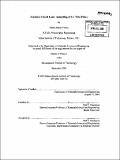| dc.contributor.advisor | Carl V. Thompson. | en_US |
| dc.contributor.author | Verma, Harsh Anand, 1980- | en_US |
| dc.contributor.other | Massachusetts Institute of Technology. Dept. of Materials Science and Engineering. | en_US |
| dc.date.accessioned | 2006-03-24T18:34:18Z | |
| dc.date.available | 2006-03-24T18:34:18Z | |
| dc.date.copyright | 2004 | en_US |
| dc.date.issued | 2005 | en_US |
| dc.identifier.uri | http://hdl.handle.net/1721.1/30257 | |
| dc.description | Thesis (S.M.)--Massachusetts Institute of Technology, Dept. of Materials Science and Engineering, February 2005. | en_US |
| dc.description | Includes bibliographical references (leaves 51-52). | en_US |
| dc.description.abstract | As the microelectronics industry has moved to Cu as the conductor material, there has been much research into microstructure control in Cu thin films, primarily because grain sizes affect resistivity. Also with Cu-based interconnects, interfacial electromigration is the dominant mechanism, and therefore the crystallographic orientation of the grains could influence reliability. Scanned laser annealing can, in principle, be used to develop test structures with extremely large grains which could be used to quantify the effects of grain boundary scattering and the role of crystallographic orientation in interfacial electromigration. Earlier research on scanned continuous laser annealing suggested that control of the thermal gradient would lead to an improved ability to manipulate grain structures. A scheme to alter the thermal profile during scanned pulsed laser annealing is implemented in the present work. Annealing of samples with Cu thin films over Si substrates with and without a silicon dioxide layer were investigated. Samples were scanned at three different velocities over a range of powers. Ablation was observed at high powers. Quasi-periodic agglomerated structures were observed below threshold powers for ablation, and grain growth was observed at lower powers. The powers at which these regimes occur, shifted towards lower power for the sample with an oxide layer. The period of the agglomerated structures was found to decrease as the power was increased and as the velocity was decreased. To clarify the effects of thermal gradient, thermal analysis based on finite element modeling was done to identify equivalent annealing conditions for the two kinds of samples. | en_US |
| dc.description.abstract | (cont.) Scaling equations to account for the affect of power and pulsing frequency on temperatures and cooling times in the sample with an oxide layer were formulated. Under equivalent conditions, the average grain length in the scanning direction was found to be higher in the sample without an oxide layer. The average grain lengths in the direction perpendicular to the scanning direction were found to be comparable. This supports expectations based on earlier work. | en_US |
| dc.description.statementofresponsibility | by Harsh Anand Verma. | en_US |
| dc.format.extent | 52 leaves | en_US |
| dc.format.extent | 1915947 bytes | |
| dc.format.extent | 1920318 bytes | |
| dc.format.mimetype | application/pdf | |
| dc.format.mimetype | application/pdf | |
| dc.language.iso | eng | en_US |
| dc.publisher | Massachusetts Institute of Technology | en_US |
| dc.rights | M.I.T. theses are protected by copyright. They may be viewed from this source for any purpose, but reproduction or distribution in any format is prohibited without written permission. See provided URL for inquiries about permission. | en_US |
| dc.rights.uri | http://dspace.mit.edu/handle/1721.1/7582 | |
| dc.subject | Materials Science and Engineering. | en_US |
| dc.title | Scanned pulsed laser annealing of Cu thin films | en_US |
| dc.title.alternative | Scanned pulsed laser annealing of copper thin films | en_US |
| dc.type | Thesis | en_US |
| dc.description.degree | S.M. | en_US |
| dc.contributor.department | Massachusetts Institute of Technology. Department of Materials Science and Engineering | |
| dc.identifier.oclc | 60842160 | en_US |
